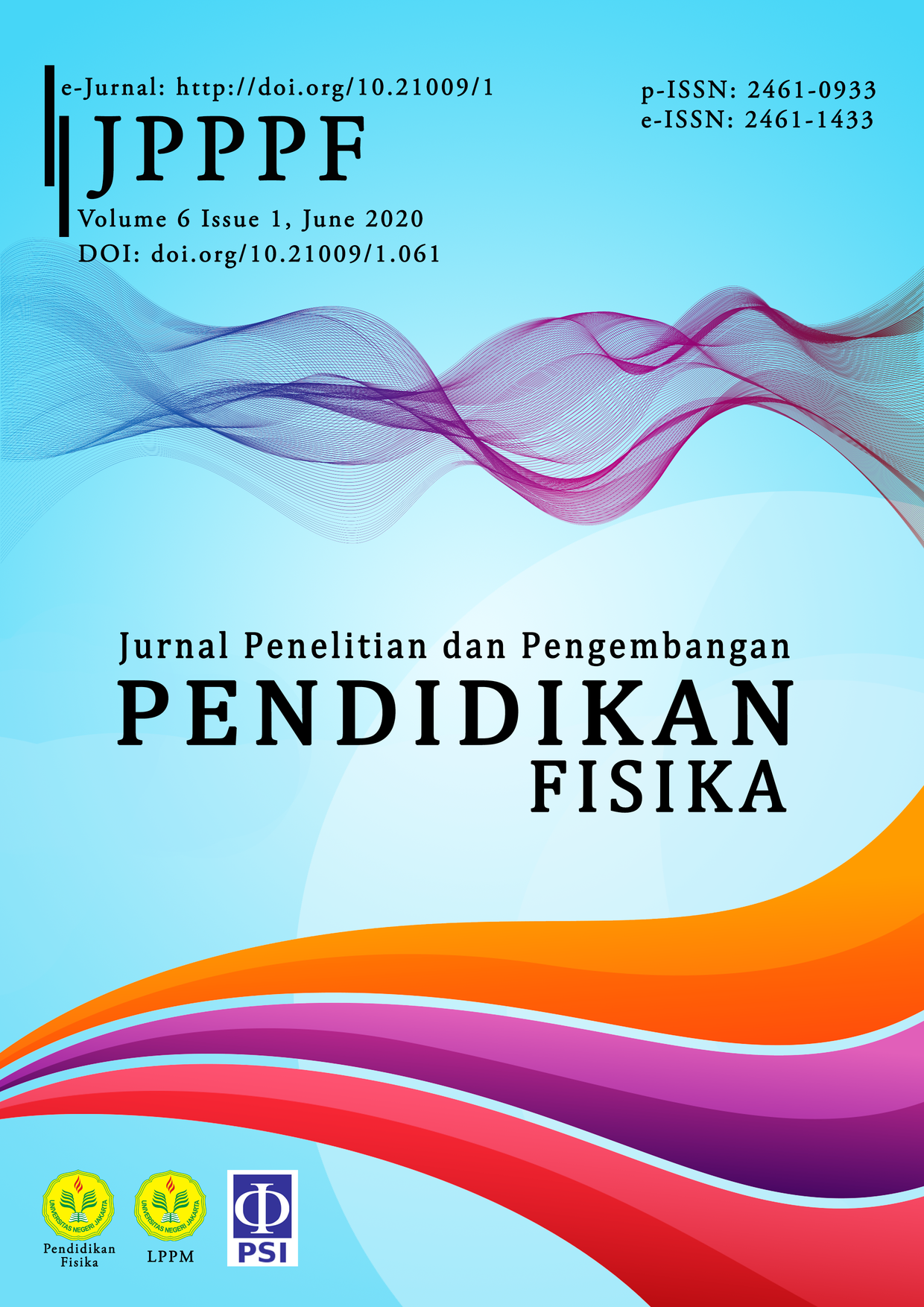The Design of One-Dimensional Motion and Two-Dimensional Motion Learning Media Using Digital Camera and Tracker-Based Air Track
DOI:
https://doi.org/10.21009/1.06107Keywords:
video analysis, tracker, two-dimensional collision, acceleration due to gravityAbstract
This research describes the results of the development of 2D air track tools designed for one and two-dimensional motion experiments with small frictional forces. Friction is minimized by using wind gusts through small holes made in all parts of the runway. Motion detection devices used are digital cameras and trackers. Digital cameras are used to record the motion of objects on a platform in the form of video with a specific frame-rate. Tracker is used to analyzing videos that contain information about object motion. This tool has been tested on one-dimensional motion, that is, an object that slides over an inclined plane and two-dimensional motion in the case of a collision of two objects. In the case of one-dimensional position graphs against time can be displayed, the instantaneous velocity and average and acceleration can be accurately determined. In the case of the collision of two objects, the position graph against time can also be displayed for each object before and after the collision. The velocity vector can be determined accurately so that the law of conservation of momentum and kinetic energy can be verified. One and two-dimensional motion are the concepts that underlie almost all other concepts in physics. Therefore one and two-dimensional motion experiments are important to build students’ experiences of the concept. Thus 2D air track platform based on digital cameras and Tracker software can be used as a physics learning media on motion kinematics materials that can display various kinematics graphs so that information about motion is complete.
References
Afriyanto, E 2015, ‘Pengembangan media pembelajaran alat peraga pada materi hukum biot savart di SMAN 1 Prambanan Klaten’, JRKPF: Jurnal Riset dan Kajian Pendidikan Fisika, vol. 2, no.1, pp. 20-4.
Ayop, SK 2017, ‘Analyzing impulse using iPhone and tracker’, The Physics Teacher, vol. 55, no. 8, p. 480.
Besson, U, Borghi, L, De Ambrosis, A, & Mascheretti, P 2007, ‘How to teach friction: Experiments and models’, American Journal of Physics, vol. 75, no. 12, pp. 1106-13.
Cáceres, J & Martínez, E 2015, ‘Utilización del plano inclinado para determinar la aceleración de gravedad’, Latin-American Journal of Physics Education, vol. 9, no. 3, pp. 3502.1-5.
Chanpichai, N & Wattanakasiwich, P 2010, ‘Teaching physics with basketball’, AIP Conference Proceedings, vol. 1263, no. 1, pp. 212-5.
Eager, D, Pendrill, AM, & Reistad, N 2016, ‘Beyond velocity and acceleration: jerk, snap and higher derivatives’, European Journal of Physics, vol. 37, no. 6, p. 065008.
Halliday, D., Resnick, R., & Walker, J 2010, Fisika Dasar Edisi 7 Jilid 1, Erlangga, Jakarta.
Haris, V & Lizelwati, N 2017, ‘Pembuatan set eksperimen untuk menentukan koefisien kinetik dan koefisien restitusi’, Sainstek: Jurnal Sains dan Teknologi, vol. 8, no. 1, pp. 38-49.
Hockicko, P, Krišt′ák, LU, & Němec, M 2015, ‘Development of students conceptual thinking by means of video analysis and interactive simulations at technical universities’, European Journal of Engineering Education, vol. 40, no. 2, pp. 145–66.
Hockicko, P, Trpišová, B, & Ondruš, J 2014, ‘‘Correcting students’ misconceptions about automobile braking distances and video analysis using interactive program tracker’, Journal of science education and technology, vol. 23, no. 6, pp. 763-76.
Kalajian, P 2013, ‘Discrepant results in a 2-d marble collision’, The Physics Teacher, vol. 51, no. 3, pp. 173-4.
Li, C 2012, ‘Bowing effect on energy conservation in an incline experiment’, Latin American Journal of Physics Education, vol. 6, no. 1, pp. 43-6.
Mahanal, S & Zubaidah, S 2017, ‘Model pembelajaran Ricosre yang berpotensi memberdayakan keterampilan berpikir kreatif’, Jurnal Pendidikan: Teori, Penelitian, dan Pengembangan, vol. 2, no. 5, pp. 676-85.
Marieta, WFD, Rusnayati, H, & Wijaya, AFC 2016, ‘Desain didaktis konsep gradien grafik v (t) sebagai percepatan atau perlambatan berdasarkan hambatan belajar peserta didik kelas X SMA’, Jurnal Penelitian & Pengembangan Pendidikan Fisika, vol. 2, no. 2, pp. 105-12.
Mustofa, MH & Rusdiana, D 2016, ‘Profil kemampuan pemecahan masalah siswa pada pembelajaran gerak lurus’, Jurnal Penelitian & Pengembangan Pendidikan Fisika, vol. 2, no. 2, pp. 15-22.
Paraskeva, F, Bouta, H, & Papagianni, A 2008, ‘Individual characteristics and computer self-efficacy in secondary education teachers to integrate technology in educational practice’, Computers & Education, vol. 50, no. 3, pp.1084-91.
Pattar, U, Raybagkar, VH, & Garg, S 2012, ‘Teaching-learning through innovative experiments: An investigation of students’ responses’, Latin America Journal of Physics Education, vol. 6, no. 3, pp. 347–52.
Pili, U & Violanda, R 2019, ‘Using a Lebron James free throw video clip to demonstrate projectile motion and energy conservation’, IOP Science: Physics Education, vol. 54, no. 1, p. 015021.
Rodríguez, CAV & Alberú, MDPS 2017, ‘La experimentación para detonar el interés en la física’, Latin-American Journal of Physics Education, vol. 11, no. 2, p. 2311-1.
Serevina, V & Muliyati, D 2015, ‘Peningkatan hasil belajar siswa pada materi dinamika gerak partikel dengan menerapkan model pembelajaran project based learning’, Jurnal Penelitian & Pengembangan Pendidikan Fisika, vol. 1, no. 1, pp. 61-8.
Suwanpayak, N, Sutthiyan, S, Kulsirirat, K, Srisongkram, P, Teeka, C, & Buranasiri, P 2018, ‘A comparison of gravitational acceleration measurement methods for undergraduate experiment’, Journal of Physics: Conference Series, vol. 1144, no. 1, p. 012001.
Vera, F, Rivera, R, & Fuentes, R 2013, ‘Learning physics with video analysis’, Nuevas Ideas en Informatica Educativa TISE, vol. 9, pp. 121-25.
Wantoro, K, Sudjito, DN, & Rondonuwu, FS 2016, ‘Pemanfaatan kamera smartphone dan eyetracking analysis pada percobaan kinematika di atas landasan udara dua dimensi’, Unnes Science Education Journal, vol. 5, no. 2, p. 1191.
Wee, LK, Chew, C, Goh, GH, Tan, S, & Lee, TL 2012, ‘Using tracker as a pedagogical tool for understanding projectile motion’, IOP Science: Physics Education, vol. 47, no. 4, pp. 448–55.











